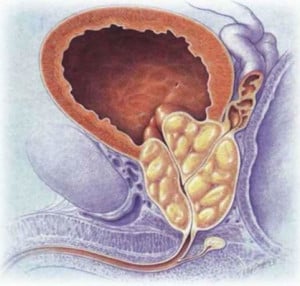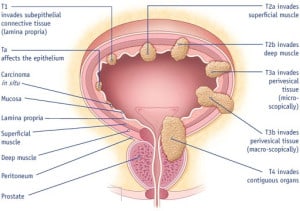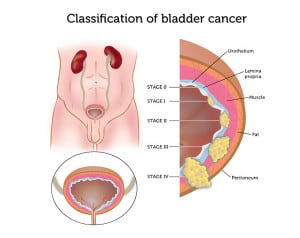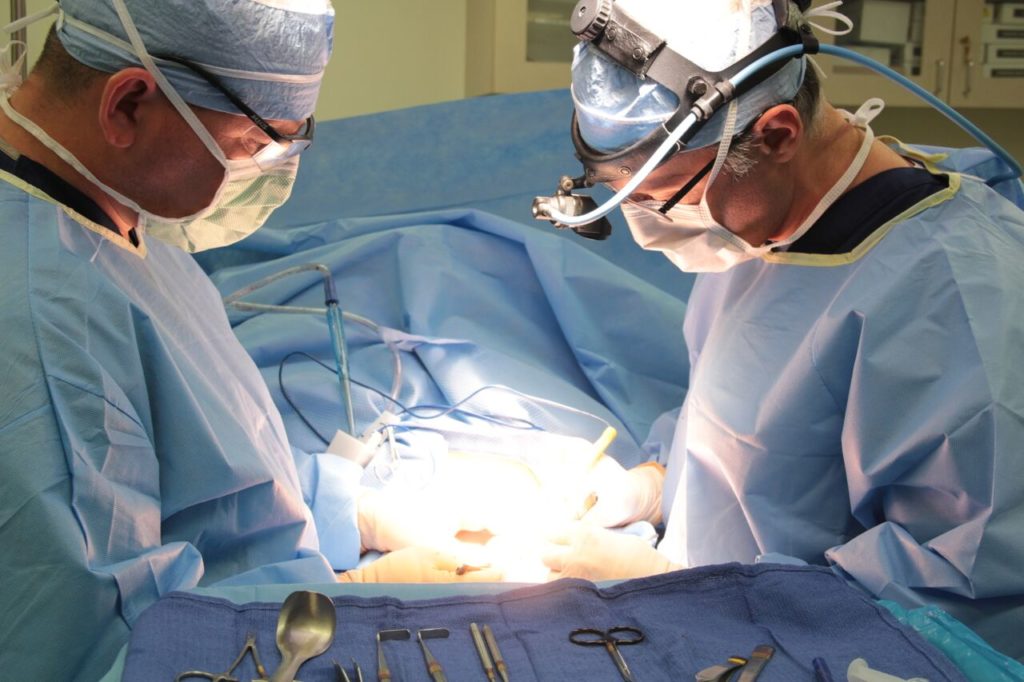 At Comprehensive Urology, our physicians are highly specialized in treating urologic cancers with the most advanced techniques. Using a team approach we strive for excellence. We aim to provide excellent cancer control, while optimizing patient satisfaction and quality of life. We work with each patient in order to specifically tailor their treatment to their own clinical situation. One of the common diseases that we treat is bladder cancer.
At Comprehensive Urology, our physicians are highly specialized in treating urologic cancers with the most advanced techniques. Using a team approach we strive for excellence. We aim to provide excellent cancer control, while optimizing patient satisfaction and quality of life. We work with each patient in order to specifically tailor their treatment to their own clinical situation. One of the common diseases that we treat is bladder cancer.
The bladder is located in the lower abdomen and its function is to store and expel urine. Urine passes from the two kidneys into the bladder via two tubes called the ureters. The bladder has an elastic muscular wall that allows it to contract and expand as urine is stored or emptied. Urine then leaves the bladder through another tube called the urethra. About 90 percent of bladder cancers form from the cells that line the urinary tract and are called transitional cell carcinomas.
Cancer that is confined to the lining of the bladder is called superficial bladder cancer. Cancer that invades into the muscular wall of the bladder or beyond is called invasive bladder cancer. Ten percent of transitional cell cancers arise in other parts of the urinary system such as the ureters, the urethra, and the part of the kidneys that collect the urine (renal pelvis).
Bladder cancer symptoms are nonspecific and sometimes can represent other urologic disorders. For this reason, our physicians perform specific screening studies to aid in the diagnosis. They perform a step by step approach to ensure the precise diagnosis is made for each patient.
Incidence of Bladder Cancer
Over 60,000 people are diagnosed with bladder cancer each year in the United States. Over the past two decades the number of cases diagnosed in the country have increased by 50%. Bladder cancer is found 3 times more often in men that in women, but women have a 30% higher chance of dying from the disease. It is found about twice as often in Caucasians than in African Americans, although African Americans and women tend to be diagnosed with a more aggressive form of the disease.
Bladder cancer is found more often in middle age (age 60-70) but can be found at any age. Younger people when diagnosed tend to have more favorable (early stage) disease.
Risk Factors for Bladder Cancer
There are many associated factors, called carcinogens, which increase the risk of bladder cancer. Smoking and tobacco use carry the greatest risk, contributing to over half of the cases. Smokers carry four times the risk of developing bladder cancer compared to nonsmokers. Smoking cessation does decrease this risk somewhat with time.
Other risk factors and carcinogens include:
- Older Age
- Chronic bladder infections
- Bladder stones
- Patients who have long term indwelling bladder catheters
- Certain parasitic diseases, such as Schistosomiasis, often found in Egypt
- Previous pelvic radiation therapy for other diseases (i.e. prostate, cervical, rectal or ovarian cancer)
- The chemotherapy cyclophosphamide (used to treat many cancers)
- Certain chemicals in the workplace (i.e. aniline dyes, combustion gases & acrolein)
Bladder Cancer Screening
Bladder cancer usually presents with blood in the urine (hematuria). It is either seen by the naked eye (gross hematuria) or by visualization under the microscope (microscopic hematuria) at the doctor’s office. Other symptoms sometimes associated with bladder cancer include frequent, painful urination and urgency of urination.
Many urologic diseases may also cause blood in the urine such as urinary tract infections, enlarged prostate (BPH), and kidney stones. For this reason, some screening tests are performed to aid in the diagnosis. These include 1) imaging studies, 2) cystoscopy, and 3) urinary evaluation. Imaging studies such as CT scan and intravenous pyelogram are used to help evaluate the urinary tract (kidneys, ureters and bladder) for abnormalities. These imaging studies involve injecting a dye that travels through the body and into the urinary tract to help give a highly defined view of the system. Cystoscopy is another exam used to evaluate for abnormalities within the bladder itself. It is a simple procedure in which a camera with a thin flexible tube is placed into the bladder through the urethra to directly visualize the lining of bladder. The urine is also tested for the presence of bladder cancer indicators or for cancer cells themselves. These tests are called NMP-22 and cytology. When used together with imaging studies and cystoscopy these tools can help detect even the hardest to find cancers in the urinary system.
Bladder Biopsy
If a tumor is found within the bladder during screening, the next step will be a bladder biopsy. This is usually a simple outpatient procedure utilizing endoscopic techniques (no skin incisions) to scrape the tumor from the bladder wall (called transurethral resection). When the tumor is superficial (confined within the lining of the bladder) and not aggressive (low grade) often this is all that is required to remove the cancer. However, when the tumor is more aggressive (into bladder muscle or high grade), more aggressive treatment may be necessary. Potentially a life-saving measure, a bladder cancer biopsy is extremely important in the treatment of cancer.
Grading and Staging of Bladder Cancer
Once bladder cancer is found, a pathologist visualizes the cells under a microscope to determine its aggressiveness (low or high grade). The cancer is also staged based on where it has spread. Tumors that are confined within the bladder lining are considered Stage Ta or T1. Tumors that invade the muscle wall are Stage T2, and those that invade beyond the bladder are termed Stage T3 and T4.
Bladder Cancer Treatments
 Treatments for Early Stage Bladder Cancer
Treatments for Early Stage Bladder Cancer
When a bladder cancer is suspected on visualization of the bladder during cystoscopy, often the definitive diagnosis and bladder cancer treatment can be performed at the same time. When bladder cancer is found early (superficial, low grade, Stage Ta or 1), usually the tumor can be removed at the time of bladder biopsy using instruments through the urinary tract (termed transurethral resection – TUR).
Sometimes when there is more than one localized tumor, or when the tumor is higher grade or recurrent, the surgeon may give additional medications directly into the bladder through a catheter to help prevent the cancer from recurring or progressing.
Treatments for Advanced Stage Bladder Cancer
AtComprehensive Urology, our aim is to provide our patients with excellent cancer control while maintaining their quality of life. Our surgeons, when clinically indicated, can perform cystectomy while preserving erectile function and urinary continence in men (prostate sparing cystectomy) and sexual function in women (vaginal wall sparing cystectomy in women). Our surgeons also are able to utilize the Da Vinci robot to perform robotic cystectomy in Los Angeles. Other treatment options that can be used alone or along with surgery in specific cases include chemotherapy and radiation.
Surgical Treatments for Advanced Bladder Cancer
Finding the right bladder cancer surgeon is critical when undergoing treatment. When bladder biopsy reveals aggressive (high grade) or invasive (into bladder muscle) bladder cancer, more aggressive treatment is required. The bladder may need to be removed in order to give the best chance for cure (termed cystectomy).
In men, traditionally the bladder, prostate and surrounding lymph nodes are removed. Most urologic surgeons only perform this type of cystectomy, and the end result is often urinary incontinence and almost always impotence.
At Comprehensive Urology cancer control as well as overall quality of life of our patients is of utmost importance. Our surgeons can help determine before the surgery if you are a candidate for prostate sparing cystectomy. In certain cases, when the prostate and the nearby bladder is not involved with cancer, the prostate capsule can be spared in order to allow a continence and nerve sparing cystectomy. The allows the patient to keep his urinary control as well as preserve erectile function in a similar manner as nerve sparing radical prostatectomy.
In women, the bladder, uterus and lymph nodes are removed. In keeping with our goal to maintain quality of life while providing excellent cancer treatment, in many women, depending on the stage of disease, our surgeons can preserve the vagina and sexual function as well.
Most surgeries are performed using an open surgical incision in the lower abdomen. Certain patients may be candidates for the robotic surgical approach. Using this approach, the cystectomy is performed by using the robotic instruments through small keyhole incisions. A small incision is then used to perform the urinary reconstruction to restore urinary drainage.
Robotic Surgery for Bladder Cancer (Da Vinci Cystectomy)
The surgery, also termed robot assisted radical cystectomy, is performed by a surgeon utilizing the Da Vinci robot to enhance minimally invasive surgical techniques in a similar manner in which it is used for prostate cancer.
Transurethral Resection of Bladder Tumors (TURBT)
Transurethral resection of the bladder is a procedure in which bladder tumors are surgically removed from the bladder wall. The procedure is most commonly used to treat bladder cancer as the majority of bladder tumors grow on the superficial layer of tissue on the bladder wall, rather than deeper into the tissue. This allows the urologist to safely remove tumors or abnormalities as minimally invasively as possible while preventing the cancerous tissue from spreading.
TURBT is an ideal treatment option for patients with suspected bladder cancer compared to traditional operations that often involve removing the bladder through open surgery. TURBT allows patients to maintain their quality of life while still overcoming a potentially harmful disease. The board-certified urologists at Comprehensive Urology are committed to providing personalized care and minimally invasive treatment designed to preserve each patient’s quality of life.
What is Involved with TURBT?
A transurethral bladder tumor resection is typically performed at a hospital or surgical center under general anesthesia or local anesthesia. The procedure involves inserting a thin flexible tube with a small light and camera known as an endoscope through the urethra into the bladder. First, water will flow up the tube to help expand the bladder and provide the urologist a clearer view of the bladder wall. Next, the urologist will use a microwave instrument or laser to cut the tumor into smaller and smaller pieces that can be flushed out of the bladder with water. The tumor will then be sent to a lab to test for cancer, which will help the urologist determine whether additional treatments will be necessary.
Recovering from TURBT
Depending on the patient, the procedure can take between 15 minutes to one and a half hours. Fortunately, the operation typically causes minor side effects that clear up within a matter of days to two weeks. The most common side effects include:
- Burning sensation when urinating
- Mild discomfort
- Change in the force of urine stream
- Blood in the urine, causing red, dark burgundy, or brown color
Most patients will also have a catheter or small tube inserted into the bladder to assist with urination while the body recovers. The surgical site as well as the urethra may be slightly swollen for a day or two following the procedure, which may interfere with urination and cause mild discomfort or burning. Once the catheter is removed, patients may experience difficulty controlling urination and blood in the urine during the recovery period, so it is important for patients to get plenty of bed rest and drink plenty of water.
Patients who develop a fever of 101 degrees or higher or experience significant bleeding should seek medical attention to ensure that any blood clots are not causing complications.
What are the Risks of Transurethral Resection of Bladder Tumors?
TURBT is a minimally invasive procedure, however, it is important to understand that any medical procedure has a degree of risk. It is crucial to undergo TURBT with a trusted and skilled urologist who is not only board-certified, but also has a strong track record of success in performing the procedure. Potential risks include:
- Bladder tumors may grow again
- Urinary tract infections
- Excessive bleeding
- Bladder damage
- Scarring of the urethra that narrows the channel
There is a risk with any medical treatment or operation. The team at Comprehensive Urology are dedicated to helping patients achieve the best possible outcome for their condition and strive to make patients as comfortable and confident as possible before any procedure. We take the time to ensure that our patients are well-informed about any treatment options and what to expect in order to provide the best comprehensive care.
Robotic Cystectomy
 The skilled urologists at Comprehensive Urology are proud to offer the latest and most advanced surgical methods available to treat bladder cancer. Depending on the severity of the disease, it may be necessary to remove all or part of the bladder, following by construction of a continence reservoir. With a robot-assisted cystectomy, patients will receive the best possible treatment with the best chance at a quick and seamless recovery.
The skilled urologists at Comprehensive Urology are proud to offer the latest and most advanced surgical methods available to treat bladder cancer. Depending on the severity of the disease, it may be necessary to remove all or part of the bladder, following by construction of a continence reservoir. With a robot-assisted cystectomy, patients will receive the best possible treatment with the best chance at a quick and seamless recovery.
To learn more about a robotic cystectomy or for a second opinion, contact the exceptional team at Comprehensive Urology in Los Angeles as soon as possible.
What are the Benefits of a Robotic Cystectomy?
Using a robotic-assisted device, such as the da Vinci Surgical System, our urologists are able to forego the invasive traditional surgeries of the past in favor of the minimally invasive accuracy provided by the da Vinci. Other notable benefits include:
- Reduced risk of blood loss
- Shorter hospital stay and recovery time
- Less scar tissue
- Minimized chance of infection
- Limited risk of complications
- Reduced post-operative pain
- 3-D visualization for surgical accuracy
Thanks to the da Vinci Surgical System, patients only receive a small surgical incision, which heals much quicker and will leave only a small scar. Best of all, the device allows the Dr. Kia Michel and the other urologists at Comprehensive Urology perform highly precise movements with improved dexterity and control, ensuring that only cancerous tissue is removed and healthy tissue is left untouched.
What to Expect after Partial or Total Bladder Removal
When all or part of the bladder is removed, patients will also undergo one of three different types of urinary reconstruction in which the patient can continue to allow urine to exit the body. These types of urinary reconstruction include:
Orthotopic Neobladder – A new bladder is created and connected to the urethra, allowing the patient to void urine as usual from the urethra.
Indiana Pouch – A type of continent urinary diversion in which a reservoir collects urine outside the body via a small stoma (opening). The patient does not require a urine bag or device, but must use a catheter to empty the pouch.
Ileal-Conduit – A type of urine diversion via a small section of the intestine, which allows the urine to empty through a small stoma (opening). Patients use an external urine collection bag or device.
The type of urinary reconstruction will depend on the patient’s health, severity of bladder cancer, as well as the patient’s preference.
Urinary Diversions
When bladder biopsy reveals aggressive (high grade) or invasive (into bladder muscle) bladder cancer, more aggressive treatment is required. This often includes bladder cancer surgery. The standard treatment involves surgical removal of the bladder (termed cystectomy) and urinary diversion to restore urine drainage.
Bladder Reconstruction Surgery
 When the bladder is removed for aggressive and invasive bladder cancer, a urinary diversion needs to be performed in order to restore normal urinary drainage. There are different types of diversion that may be performed depending on each patient. These include:
When the bladder is removed for aggressive and invasive bladder cancer, a urinary diversion needs to be performed in order to restore normal urinary drainage. There are different types of diversion that may be performed depending on each patient. These include:
Ileal conduit: our surgeons use a small segment of the small intestine (termed the “ileum”) and attach the ureters to one end of the segment. The other end is connected to the lower abdominal wall to allow urine to exit into a small drainage bag (termed a urostomy) through a nickel size opening. It is considered the least complicated of urinary diversions
Neobladder: our surgeons use a longer segment of the intestine to make a new bladder (“neo-bladder”). The intestine is reconstructed into a spherical shape resembling the normal bladder. This is then connected to the urethra to allow patients to urinate more naturally and not need any external devices such as a “bag”. When used with prostate sparing cystectomy, this can provide the patient with a new bladder and complete urinary control while preserving erectile function.
Continent reservoir: For eligible patients who cannot have the neo-bladder connected to their urethra (i.e. invasive cancer into the pelvis, previous extensive pelvic irradiation), but prefer not to have an external “bag”, our surgeons use the intestine to create a new bladder (neo-bladder) and create a continence mechanism for it. It is the connected to the abdominal wall. Patients then drain the pouch every several hours with a catheter, so no permanent external drainage bag is used.
Other Treatments for Advanced Bladder Cancer
Chemotherapy: Chemotherapy can be utilized in multiple ways for the treatment of bladder cancer. When a patient has a cancer that is highly aggressive, chemotherapy can is sometimes be advised by a bladder cancer surgeon in Los Angeles (either before or after surgery) to help decrease the chance of spread (metastasis). Chemotherapy also is used to treat metastatic bladder cancer (cancer that has spread to other organs).
Radiation Therapy: Although surgery and chemotherapy are considered the main treatment for advanced bladder cancer, simultaneous chemotherapy and radiation can be used as an alternative to try to save the bladder (bladder sparing therapy). This type of treatment is only about 40% effective in controlling bladder cancer.
Neobladder
 When a patient has been diagnosed with aggressive or invasive bladder cancer, it is often necessary to take an aggressive approach to eliminating the disease and preventing it from spreading to the rest of the body. In most cases, advanced stages of bladder cancer are treated by surgically removing the bladder (a procedure called cystectomy) and restoring urinary draining through urinary diversion. In order to help maintain normal urinary function, rather than relying on an external drainage bag, a new bladder (Neobladder) is constructed from a segment of the small intestines.
When a patient has been diagnosed with aggressive or invasive bladder cancer, it is often necessary to take an aggressive approach to eliminating the disease and preventing it from spreading to the rest of the body. In most cases, advanced stages of bladder cancer are treated by surgically removing the bladder (a procedure called cystectomy) and restoring urinary draining through urinary diversion. In order to help maintain normal urinary function, rather than relying on an external drainage bag, a new bladder (Neobladder) is constructed from a segment of the small intestines.
Overcoming a serious illness such as cancer can be intimidating and overwhelming, but it is important to work with a skilled medical team who will not only fight to protect your health and quality of life, but also listen to your concerns and needs. Comprehensive Urology strives to ensure that patients can maintain as much normal function as possible while still eliminating harmful diseases such as bladder cancer.
What is a Neobladder?
A Neobladder is a portion of the patient’s small intestine that is reconstructed and joined to the ureters, which bring urine from the kidneys to the new bladder, and the urethra, which allows the urine to exit the body. The section of the small intestine is formed into a small pouch that mimics the reservoir function of the bladder and helps prevent urine from backing up and causing infection in the kidneys. However, patients will have to adjust to the temporary and permanent changes that may happen to their body as a result of the surgery, such as an initial lack of muscle control over the Neobladder compared to the natural bladder. The urologists and nursing staff at Comprehensive Urology and Cedars Sinai Medical Center will work closely with the patient to ensure that the adjustment is as comfortable and seamless as possible.
Rehabilitation and Side Effects
Since a cystectomy and Neobladder procedure often involves removing surrounding pelvic organs, such as the prostate in men, and the uterus, fallopian tubes, and ovaries in women, the recovery process will vary from patient to patient. Patients may need to spend up to two or three weeks in the hospital to avoid any possible complications as well as to provide assistance with the process of using the Neobladder.
It may take several months for patients to regain their strength and return to normal activities, such as driving, going back to work, and exercising. During the first few weeks at home, patients will have a catheter to assist with urination as the body continues to heal. Once the catheter is removed, patients will be instructed on how to use the new bladder. Initially, the Neobladder will have to be emptied every one to three hours, gradually building up over time as the bladder capacity increases.
In some cases, patients may have to use a catheter each time they need to empty their bladder in order to ensure that there is no residual urine remaining. If the bladder is not completely drained, it could result in urinary tract infections or kidney or bladder stones.
The small intestine used to create the Neobladder will naturally secrete a thick mucus that will be present in the urine. It will be necessary for the patient to regularly flush the bladder to cleanse the mucus from the bladder and prevent blockages.
What are the Advantages and Disadvantages of a Neobladder?
As with any surgical procedure, there are pros and cons to consider, especially if an organ is completely removed. The Neobladder is preferable for many patients because it most closely mimics the normal urination process and protects the kidneys from infection or kidney stones. However, recovering from the Neobladder operation can be lengthy and result in urinary leakage and regular self-catheterization.
It is important to discuss your concerns and whether you are a viable candidate for a Neobladder with the skilled urologists at Comprehensive Urology.
Ileal Conduit
 An ileal conduit, also known as a urostomy, is a type of urinary diversion technique in which a urologist creates a system of urinary drainage with a section of the patient’s small intestine. This procedure is one of several treatment options for patients that must undergo a cystectomy or total removal of the bladder due to muscle-invasive bladder cancer, recurrent bladder tumors that do not respond to transurethral resection or chemotherapy, chronic inflammation of the bladder, or birth defects.
An ileal conduit, also known as a urostomy, is a type of urinary diversion technique in which a urologist creates a system of urinary drainage with a section of the patient’s small intestine. This procedure is one of several treatment options for patients that must undergo a cystectomy or total removal of the bladder due to muscle-invasive bladder cancer, recurrent bladder tumors that do not respond to transurethral resection or chemotherapy, chronic inflammation of the bladder, or birth defects.
This procedure is permanent and life-saving, particularly for patients facing advanced stages of cancer. Choosing to under an ileal conduit is not a decision to take lightly and the expert urologists at Comprehensive Urology strive to help patients achieve the best possible outcome for their condition. If a patient is a valid candidate for ileal conduit, our team will work tirelessly to preserve the patient’s quality of life and physical function.
What is an Ileal Conduit?
An ileal conduit redirects urine from the kidneys to an external bag located on the outside of the abdomen. The urinary diversion is created using a section of the small intestine called the ileum that is surgically sewn to the ureters from the kidneys to a small opening created through the abdominal wall called a stoma. Following the surgery, a small plastic bag will be attached around the stoma to collect urine from the ureters.
The patient will be responsible for cleansing and protecting the stoma, which can be sensitive to bacteria, as well as the tissue surrounding the stoma that will be exposed to caustic urine. It is important for patients to monitor urinary flow and regularly empty the urinary bag.
What to Expect During Recovery
Following a cystectomy and ileal conduit operation, patients will need to spend about a week in the hospital to ensure professional care and prevention of complications. Full recovery can take up to six to eight weeks, during which patients will receive regular checkups to monitor how well the patient is healing and adapting to the stoma. In many cases, additional pelvic organs are removed during a cystectomy to ensure that the cancer cells do not spread. For men, this often means removal of the prostate and lymph nodes, and for women it means removal of the uterus, ovaries, falopian tubes, and even a part of the vagina. At Comprehensive Urology, our team strongly believe in preserving as much healthy tissue and bodily function as possible and may take action to prevent removing surrounding pelvic organs.
What are the Advantages and Disadvantages of an Ileal Conduit?
Ileal conduit urinary diversion is an ideal option for those undergoing a cystectomy because it is a safe and effective procedure that can be completed in less time than other, more complex operations. The stoma and urinary bag also allow patients to avoid the occasional self-catheterization that is often required with other procedures, such as a Neobladder.
The few disadvantages of an ileal conduit include having to care for an external bag that collects urine and may leak or cause odors. Many patients face the psychological impact of a sudden change in body image and must learn to adapt to the new responsibilities of caring for a stoma and urinary bag. One of the main risks associated with an ileal conduit is the potential for urine collecting in the kidneys, which can lead to kidney infections, stones, and organ damage.
There are pros and cons to any type of urinary diversion technique and it is important to discuss your options and concerns with a highly trained and experienced urologist, such as Dr. Kia Michel. Undergoing an organ removal and creation of a stoma is a major decision, but the dedicated team at Comprehensive Urology take the time to help patients make an informed decision that they can be comfortable and confident with.
To learn more about bladder cancer treatment, visit WebMD.com.
Frequently Asked Questions
Q: What is a cystoscopy?
Q: What are the side effects of cystoscopy?
Q: Are there any limitations after the procedure?
Q: How is a bladder biopsy performed?
Q: Will I need a bladder catheter after the procedure?
Q: What are common side effects?
Q: Are there any limitations after the procedure?
Contact a Bladder Cancer Treatment Specialist
Bladder Cancer can be treated by understanding what your options are and by choosing the best expert Urologist. If you feel you may be at a risk for bladder cancer, contact our Los Angeles Urologists today for your initial consultation by calling (310) 499-2756.
Next, read about Testicular Cancer.